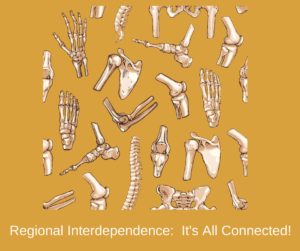
What is Regional Interdependence?
The term Regional Interdependence has been a buzzword in physical therapy education over the past 10 years as an examination model to account for how the body performs as a functional unit or how one region can influence another. In other words, it is the concept to explain how a patient’s low back pain can be caused by their hip weakness, or that their knee pain is related to poor foot mechanics during walking. As a general rule, a physical therapist will not only evaluate the specific area where a patient has their pain complaints, but also a joint above and below the location of primary symptoms. (In some cases, an even broader approach may be utilized.). Through this framework of evaluation and treatment, physical therapists are able to more fully assess each patient as a whole, instead of as a collection of individual body parts. This assessment style leads to a more functional approach to rehabilitation that addresses the underlying issues that result in pain and dysfunction, as opposed to simply managing the resultant symptoms.
Why does this approach matter?
Often, patients may be confused as to why a PT is evaluating their hips and low back when they came in with knee pain, or why it is suspected that their arm and hand pain is being caused by an issue with their neck. During the course of an evaluation and treatment, physical therapists are interested in how the body is able to function as a unit, and if there are any structures or deficits that are impeding that process. The human body is wonderfully complex and it follows that symptoms and pain rarely exist in isolation, but are the result of multiple deficits and/or compensatory habits that accumulate over time. The ability to identify and address these deficits in mobility, strength, stability or coordination, and then consider how they relate to the manifestation of symptoms, can help a therapist to more fully and efficiently address their patients’ foundational issues. This treatment strategy then ultimately aims not only to resolve current symptoms, but to improve general function and decrease the probability of recurrent, long term issues.
Some examples to consider:
There is a growing body of evidence-based research that showcases the benefits and effectiveness of a regional interdependence approach to recovery and rehabilitation. Being aware of some of the common conditions that benefit from a regional interdependence approach can assist in maximizing recovery and avoiding frustration with symptoms that are not as responsive to a more narrow treatment approach.
Knee Osteoarthritis– The knee joint is the unofficial star of the regional interdependence approach, in part because of how affected it is by the ankle, foot and hip. Treatment for knee pain in general and for osteoarthritis specifically should contain a large element of addressing foot/ankle mechanics and mobility as well as hip strengthening. This approach helps to improve the load bearing stability of the lower body as well as to decrease the forces at the knee that often cause irritation.
Shoulder Impingement– Issues with chronic shoulder irritation can frequently be related to poor postural management during repetitive movements. In order to address appropriate postural strength and mobility, interventions to improve neck motion along with thoracic spine mobility and scapular (shoulder blade) strengthening can largely impact shoulder symptoms.
Low Back Pain– Data shows that approximately 80% of people will experience an episode of low back pain during their life. Back pain is the #2 cause of disability in the United States. Clearly, back pain is a big deal and treating it effectively is an important factor in recovery. In addition to addressing lumbar mobility and core strengthening, a regional interdependence approach to treatment would focus on other factors that can contribute to low back pain, including pelvic position, thoracic mobility, hip strength, foot mechanics and functional movement patterns for appropriate gait, squatting and lifting strategies.
Do you have nagging pain or injuries that keep you from performing at your best? Have you tried treatments in the past that didn’t seem to address the whole issue? If so, you’d likely benefit from a physical therapy assessment that considers your symptoms through a framework of regional interdependence. At Symmetry Physical Therapy, you’ll find therapists that are experts in this approach to rehabilitation. We would love to help design a treatment plan to help you feel your best!
